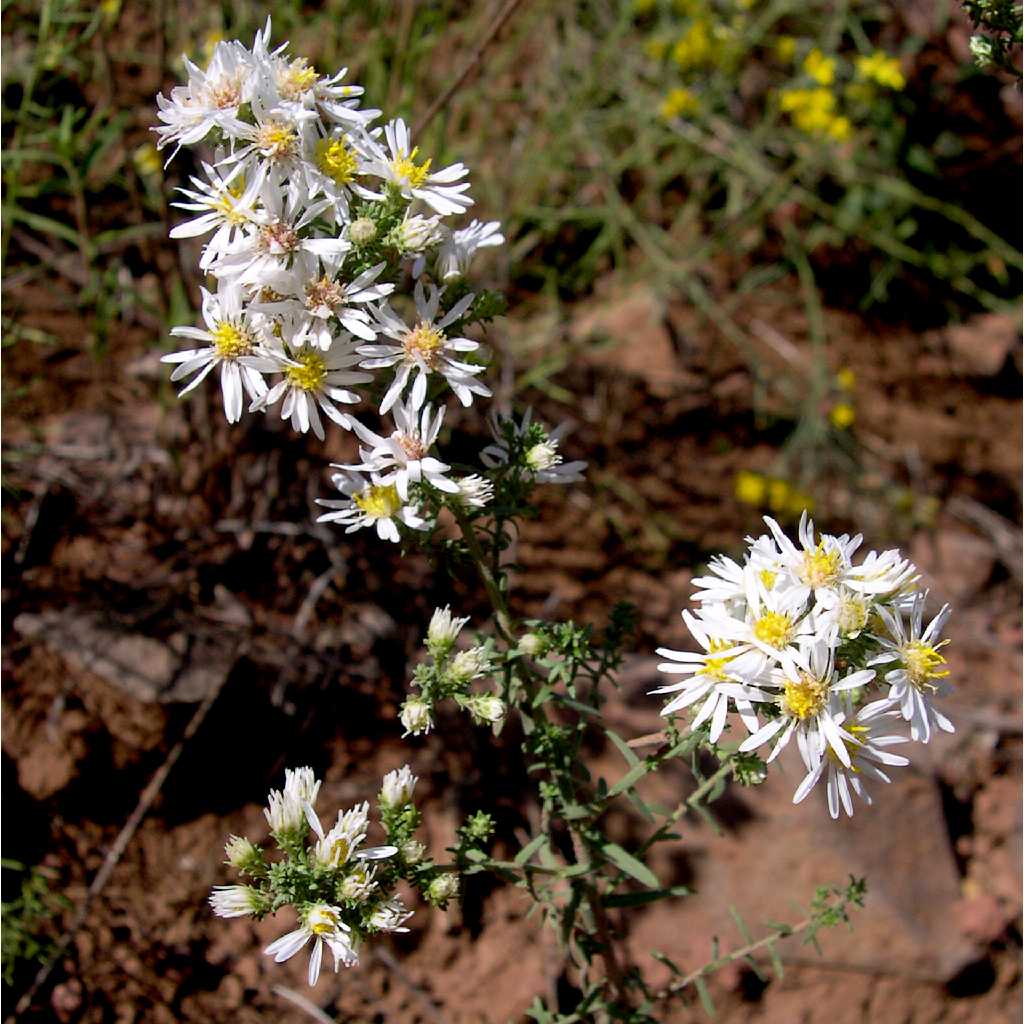Symphyotrichum
|
Family: Asteraceae |
Annuals or perennials, 2-200 cm (colonial or cespitose, usually ± strongly heterophyllous, usually eglandular, sometimes stipitate-glandular; rhizomatous, with woody caudices, or taprooted). Stems ascending to erect, rarely vinelike, usually simple, sometimes branched distally, seldom proximally, usually hairy in decurrent lines at least distally, proximally often glabrous, sometimes hairy, sometimes stipitate-glandular distally. Leaves basal (sometimes persistent to flowering) and cauline; petiolate (often basal and proximal, sometimes distal, petioles often ± winged, clasping, ciliate) or sessile; blades (often purplish abaxially, 1, sometimes to 3-nerved) cordate to elliptic, oblanceolate, or spatulate (basal), ovate, elliptic, lanceolate, oblanceolate, or linear (cauline, usually progressively, sometimes abruptly or little reduced distally), margins serrate, crenate, or entire, scabrous or ciliate, faces glabrous or hairy, sometimes stipitate-glandular. Heads radiate or disciform (sect. Conyzopsis), usually in paniculiform, sometimes in racemiform or subcorymbiform arrays, sometimes borne singly. Involucres cylindric or campanulate to hemispheric, 4-22 mm diam. Phyllaries 20-84 in (3-)4-6(-9) series, 1(-3)-nerved (not keeled), oblong-lanceolate or oblanceolate or spatulate (outer and mid) to linear (innermost), unequal to subequal, outer sometimes foliaceous, bases usually indurate, margins usually scarious, erose, hyaline or not, (apices usually with a well-defined green zone, sometimes ± foliaceous), faces glabrous or hairy, sometimes stipitate-glandular. Receptacles flat to slightly convex, pitted, epaleate. Ray florets (8-)12-35(-75+); usually in 1 series, in 2-5 series, rarely in 4-5+ series in S. frondosum, pistillate, fertile; corollas white, pink, blue, or purple (rays 0, peripheral pistillate florets in 2-5+ series, corollas lacking laminae in sect. Conyzopsis). Disc florets (7-)15-50(-110), bisexual, fertile; corollas yellow to white, becoming purplish to reddish or pinkish at maturity, ± ampliate, tubes usually shorter than funnelform (cylindric in sect. Conyzopsis) throats, lobes 5, erect, spreading, or reflexed, deltate, triangular, or lanceolate; style-branch appendages lanceolate. Cypselae usually obovoid or obconic, sometimes fusiform, ± compressed, nerves (2-)3-5(-10, sometimes dark-translucent), faces glabrous or strigillose, eglandular ( The taxonomy followed here is based partly on G. L. Nesom (1994b, 1997), with the removal or addition of species based on molecular phylogenies (e.g., J. C. Semple et al. 2002; L. Brouillet and S. Selliah 2005). A. G. Jones (1980) and J. C. Semple and L. Brouillet (1980) proposed classifications of North American asters in which the group now segregated as Symphyotrichum was recognized at various levels. A morphologically based phylogenetic analysis of North American asters was done by Jones and D. A. Young (1983). They identified a group similar to the current Symphyotrichum, but did not segregate it from Aster. G. L. Nesom (1994b, 1997) segregated Symphyotrichum from Aster in a strict sense on a morphologic basis. This segregation was supported by the molecular phylogenetic analysis of R. D. Noyes and L. H. Rieseberg (1999), and confirmed by later data (Semple et al. 2002). Nesom (1994b) provided a summary of the literature on the taxonomy of North American asters. As here circumscribed, Symphyotrichum excludes members of subtribe Symphyotrichinae with x = 9 (Almutaster, Ampelaster, and Canadanthus), as well as Psilactis (x = 9, 5). These taxa form a grade basal to Symphyotrichum in molecular phylogenies. The genus includes species with x = 8, 7, 5, 13, 18, and 21 (see G. A. Allen 1986), with disploidy to 4 from x = 5. G. L. Nesom (1994b) provided reference to chromosome counts in the genus, and J. C. Semple (1995) reviewed cytologic data. At the present time, karyologic evolution within the genus remains unresolved due to lack of phylogenetic resolution among subgenera and sections in molecular phylogenies. The most basal species appears to be the isolated S. chapmanii (n = 7), a taxon that was unusual in Eurybia (x = 9) on morphologic and cytologic grounds (Semple 1982). Section Conyzopsis also has x = 7; its karyotype is similar to that of x = 8 subg. Symphyotrichum where it is placed. Subgenera Virgulus and Astropolium both have x = 5 (and 4 in the former); their karyotypes differ and currently they do not group in molecular phylogenies. The n = 13, 18, and 21 entities of subg. Ascendentes are polyploids resulting from hybridization between members of subgenera Symphyotrichum and Virgulus in the western United States (Allen 1985, 1986). Ta |

